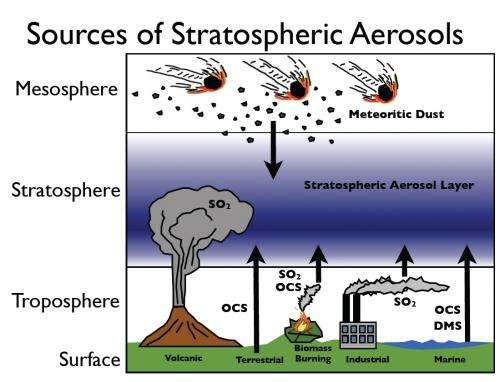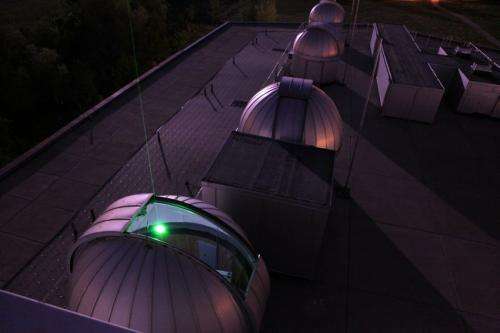Sources of aerosols reach the stratosphere from above and below, as shown in the graph. Sulfur dioxide (SO2), carbonyl sulfide (OCS), and dimethyl sulfide(DMS) are the dominant surface emissions which contribute to aerosol formation. (Credit: NOAA)
(PhysOrg.com) -- A new study led by the U.S, National Oceanic and Atmospheric Administration (NOAA) shows that tiny particles that make their way all the way up into the stratosphere may be offsetting a global rise in temperatures due to carbon emissions. And while scientists cannot yet say with any certainty where exactly the particles are coming from, they are saying that they have confidence that such particles have likely muted global temperature gains by as much as a third of what they would have been. They team, led by John Daniel, a physicist at the NOAA Earth System Research Laboratory (ESRL) in Boulder, CO, has published their results in Science.
The new research has focused on aerosols, the tiny solid or liquid particles that exist in the atmosphere that can affect global temperatures, such as when Mt. Pinatubo in the Philippines, erupted in 1991 causing a worldwide average decrease in temperature of 1 degree Celsius for more than a year. The cooling is not the result of the ash, notes co-author Susan Soloman, but from the sulfur dioxide that is thrust all the way up into the stratosphere, where it oxidizes and adds to the sun reflecting properties of other already existing particles.
The team focused on the most recent decade because of the relative absence of massive volcanic eruptions , giving them a more clear environmental view of how much impact minor volcanic eruptions and human activities have on the amount of aerosols in the atmosphere and thus global temperatures. To find out what was going on, they used both ground based data and information from satellites such as Cloud-Aerosol Lidar and Infrared Pathfinder Satellite Observations (Calipso), to measure the amount of aerosols in the atmosphere and at what altitudes.
NOAA has released a statement outlining the results of the study, and in it Daniel, says, “stratospheric aerosol increased surprisingly rapidly in that time, almost doubling during the decade,” which forms the basis of the teams conclusions that such aerosols are responsible for the slowdown in increased temperatures that scientist around the world have been expecting due to greenhouse gas emissions.
Lidar instruments - pointing up from the ground or down from satellites - use reflected light to measure the amounts of particles and their locations, which can influence climate. (Credit: CIRES/NOAA)
The surprising aspect of the study is the large amount of aerosols found during a period when there weren’t any giant volcanoes going off, which leads researches to wonder if the aerosols are from the combined effects of multiple small eruptions, or human activity, such as the particles emitted from coal fired power plants, particularly in Asia, where such plants have multiplied in recent years. One thing the research is not able to tell us is what impact aerosols will likely have in the future, because of the uncertainty of their origin, which means there is no way to tell at this point if there will be more, or less of them, which means scientists can only guess if the temperature muting will continue to offset global warming from current and future carbon emissions.
More information: The Persistently Variable “Background” Stratospheric Aerosol Layer and Global Climate Change, Science DOI:10.1126/science.1206027
ABSTRACT
Recent measurements demonstrate that the “background” stratospheric aerosol layer is persistently variable rather than constant, even in the absence of major volcanic eruptions. Several independent data sets show that stratospheric aerosols increased in abundance since 2000. Near-global satellite aerosol data imply a negative radiative forcing due to stratospheric aerosol changes over this period of about –0.1 W/m2, reducing the recent global warming that would otherwise have occurred. Observations from earlier periods are limited but suggest an additional negative radiative forcing of about –0.1 W/m2 from 1960 to 1990. Climate model projections neglecting these changes would continue to overestimate the radiative forcing and global warming in coming decades if these aerosols remain present at current values or increase.
© 2010 PhysOrg.com




















